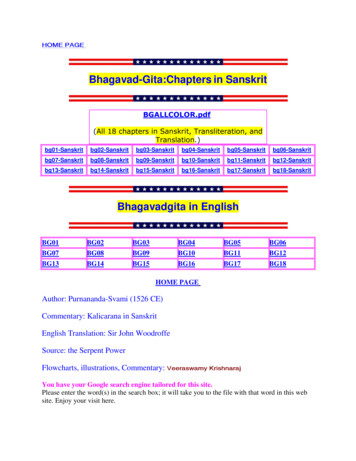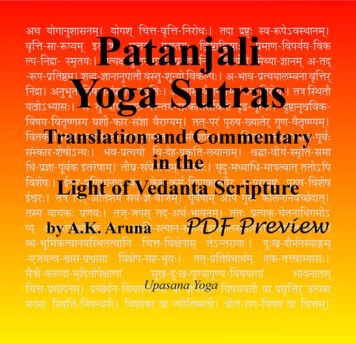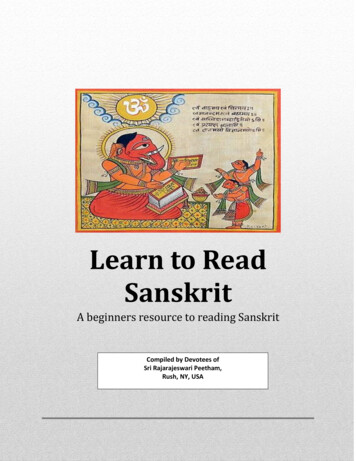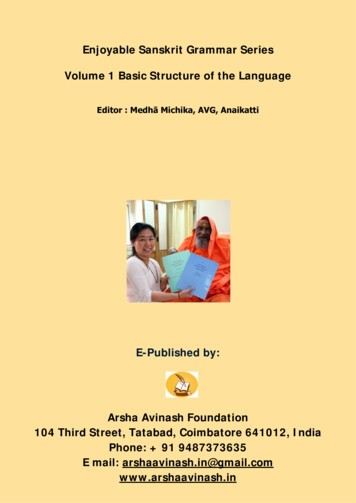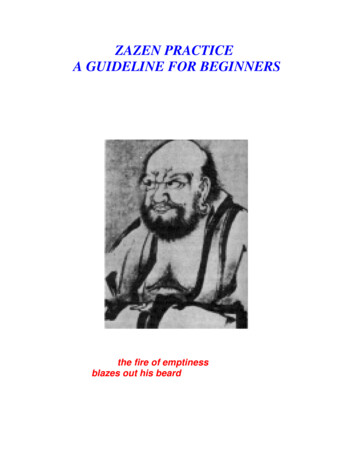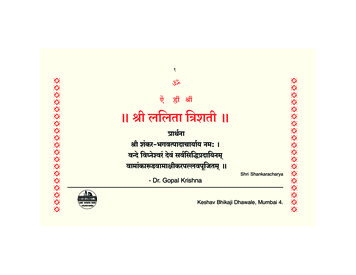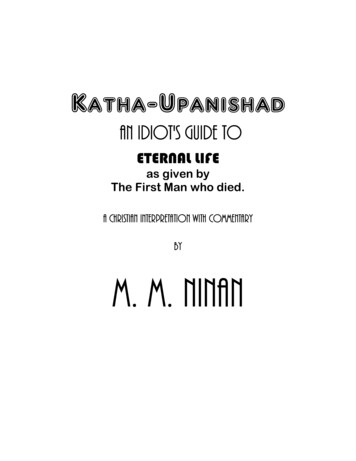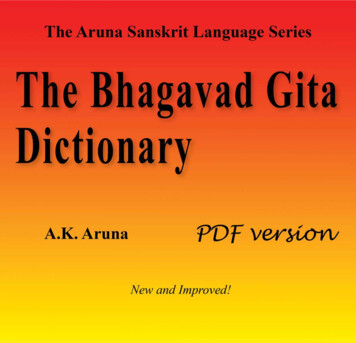
Transcription
The Aruna Sanskrit Language SeriesThe Bhagavad GitaDictionaryA.K. ArunaPDF versionSecond EditionUpasana Yoga Media
Second edition 2012Copyright 2012 Upasana YogaAll rights reserved.No part of this publication may be reproduced or distributed in any formor by any means without the prior written permission of the publisher.ISBN (PDF): 978-1-938597-02-2Published byUpasana Yoga MediaPalm Desert, CAwww.UpasanaYoga.orgThis ebook is licensed for your personal enjoyment only. This ebook may not be re-sold or given away to otherpeople. If you would like to share this book with another person, please purchase an additional copy for eachrecipient. If you’re reading this book and did not purchase it, or it was not purchased for your use only, then pleasereturn and purchase your own copy. Thank you for respecting the hard work of this author.
Invocation ËËÕË ËmË@ Ë«Ë‚Ä;Å Ë ËÕ@ ëËe’Ë ËÕË ß Ë«Ë«Ë} ’ËÎ@ ‚ËÕ‚’Ë ËÎ@ ëËe’Ë Ë ËË jË Ë«ËÏ ÎÕ Ë Ë}GNārāyaṇaṃ namaskṛtya naraṃ caiva narottamam.Devīṃ sarasvatīṃ caiva tato jayam udīrayet.Bowing to Lord Nārāyaṇa (Kṛṣṇa), to Nara, the best of men [namely Arjuna], and to the Goddess [ofknowledge] Sarasvatī, then may one commence the [lore called] Jaya (Victory).Mahābhārata 1.1
The Aruna Sanskrit Language SeriesThe Aruna Sanskrit Language Series is a groundbreaking series of media that enriches the study ofboth the Sanskrit language and Vedanta. The six titles currently in the series are highly flexibleand cross-referenced, guiding readers through Sanskrit basics to proficient level—unlocking thevocabulary and grammar and helping them comprehend the deeper meaning of the BhagavadGita. These titles are available through the publishing arm of Upasana Yoga atwww.UpasanaYoga.org.Other Titles in The Aruna Sanskrit Language Series (available in Print & PDF)The Aruna Sanskrit Grammar ReferenceThe Aruna Sanskrit Grammar Coursebook: 64 Lessons Based on the Bhagavad Gita Chapter TwoThe Bhagavad Gita Reader: Sanskrit/English Parallel TextThe Bhagavad Gita Sanskrit Key: Verse-by-Verse Grammar & VocabularyThe Sanskrit Reading Tutor: Read It, Click It, Hear It! (only in PDF)Other Titles by A.K. ArunaThe Bhagavad Gita: Victory Over Grief And DeathPatanjali Yoga Sutras: Translation and Commentary in the Light of Vedanta ScripturePatanjali Yoga Sutras: A Translation in the Light of Vedanta Scripture
AcknowledgmentsTimeless adoration to my guru, Swami Dayananda Saraswati, a brilliant link in the tradition between theoriginal knowledge of reality and today. Under his tutelage many gifted teachers are reinvigorating theVedanta teaching tradition throughout India and the world in many different languages.In preparing the Bhagavad Gita Dictionary I am indebted to Swami Dayananda Saraswati’s BhagavadgitaHome Study Course, the Bhashya of Sri Sankaracarya, Taranatha Bhattacharya’s Sabdastoma-Mahanidhi (ASanskrit Dictionary), Macdonell’s A Practical Sanskrit Dictionary, Sir Monier Williams’ A Sanskrit-EnglishDictionary and his A Dictionary, English and Sanskrit, V. P. Apte’s The Practical Sanskrit-English Dictionary,The Student’s English-Sanskrit Dictionary and his Sanskrit-Hindi Kosha, Pandit S. Ramasubba Sastri’sKridantarupamala, Krishna Vishor’s Gita Prakasa, and finally Amritsariya Ram Bhanot’s Shrimad BhagavadGita with Amritavarshini Tika.I hope you enjoy this dictionary as much as I did compiling it.7
Abbreviationsa. or adj.abl.acc.act.adv.aor. aspir.!ËË or Ā.aug.b/4bene.¿Ë; adjective(s)ablativeaccusativeactiveadverbaorist (tense)as first memberas second veB.H.S.C.Bṛhadāraṇyaka UpaniṣadBhagavadgītā Home StudyîË Chāndogya .den.des.du.encl.esp.ex.f. or fem.fr.fut.fut. pt.gram.gutt.impf.impv.in.in. pt.inf.intens.interj.irreg.Course, by Swami ion(s)denominative(s)ÄÅ m. or masc.mid.n. or neut.nom.num.opt.orig.ºËÕ , Par. or nine(s)fromfuturefuture participle linableindeclinable egularKaṭha Upaniṣadmasculine(s)middle y)originallyParasmaipada
Abbreviations (cont.)pt.pcl.ps.past act. pt.pp.perf.peri.pl.poss.poss. prn.pot.pot. ps. pt.prep.pr.pr. pt.pr. mid. pt.pri.prn.prn. a.redup.redup. perf.pt.participle(s)particle(s)passivepast active participlepast participle (passive)perfect (tense)periphrasticpluralpossiblypossessive pronounpotential (mood)potential passive participlepreposition(s)presentpresent participle (active)present middle participleprimarypronounpronominal adjectivereduplicated/reduplicationreduplicated perfect participle(active)reflex.rel.resp.& ’Ë s.s.f.sec.semiv.sibi.sg.spv.suff.‹Ë Ëe term. g Vedarootstrongstem lativesuffix(es)Śvetāśvara UpaniṣadTaittirīya )weakwithwith or without
The Aruna Sanskrit Language SeriesThe first title in The Aruna Sanskrit Language Series is The Aruna Sanskrit Grammar Reference. The GrammarReference follows the reference style presentation of grammar. This will provide a logical, consistent andcomplete exposition of the grammar for reading-only proficiency. The grammar uses minimal wording andpresents the material in outline and chart form as much as possible to maximize your visual memory of theinformation. This method also greatly assists review and re-review of the grammar, necessary to master thesubject. Several of the charts have multiple forms within them that demonstrate simple, easy to rememberpatterns which are overlooked by many grammar books. This helps you to also logically remember theinformation. The grammar is presented in the Western style, which emphasizes analytic, reading skills, asopposed to the more difficult composition and speaking skills. As much as possible, the examples in the bookare taken from the Bhagavad Gita, so your targeted vocabulary builds quickly.The second title in The Aruna Sanskrit Language Series is The Aruna Sanskrit Grammar Coursebook: 64 LessonsBased on the Bhagavad Gita Chapter Two. The exercise in the first lesson of the Aruna Coursebook directs the studentto the Script Reading Exercise, given in its appendix. This section provides the complete Bhagavad Gita secondchapter in large-print Sanskrit with transliteration using the English alphabet under each line, followed with theentire chapter again with only the large-print Sanskrit to test your progress. The text and transliteration arebroken down in two separate ways to show the separate syllables and then the individual words, thusprogressively showing the student the proper methodology for correctly pronouncing the original Sanskrit text.This section should provide all the necessary practice material for the student to learn the Sanskrit script—essential for proceeding through the rest of this work and any other Sanskrit work. For students who need helpin pronunciation of Sanskrit words, I highly advise finding a teacher, a friend or someone in your communitywho will surprise you with their readiness to assist you—knowledge of Sanskrit and its literature seems tonurture this helpful attitude. These people need not know the meaning of all the Sanskrit words, but they canread the Sanskrit script. Additionally, a tape or CD of the Bhagavad Gita is available through the Arsha VidyaGurukulam (www.arshavidya.org).An alternative help for this Script Reading Exercise is the specially developed Sanskrit Reading Tutor: Read It,Click It, Hear It!, a uniquely formatted PDF file that has the alphabet sections from the Grammar Reference plusthe Script Reading Exercise of the Grammar Coursebook. The special feature of the PDF is that one can click on anyof the characters in the alphabet section to hear its pronunciation, and on any of the individual lines, quarter11
THE ARUNA SANSKRIT LANGUAGE SERIESverses, or their syllables of Script Reading Exercise to hear their pronunciation. In this way one can have eachof these script elements individually re-read to you over and over while you are seeing the script on yourscreen—a unique and invaluable tool for learning the script and its pronunciation.The rest of the lessons in the Aruna Coursebook give a relatively quick overview of the entire GrammarReference—its layout, its methodology and how its grammar rules are to be understood. Enough explanationwith little redundancy is provided to explain the outlined and charted grammar presented in the GrammarReference so that you can learn on your own with little or no assistance from a teacher, assuming you can apply apost-high school aptitude towards this work.The examples and exercises in the Aruna Coursebook are drawn from the second chapter of the BhagavadGita, which is taught completely in prose format, then finally in verse format. In the Aruna Coursebook,vocabulary is presented by giving the English meaning of the individual words, their grammar and also theircontextual use within expressions from the Gita. This should make it very easy to learn the vocabulary. Byteaching the vocabulary of the verses in a consistent Sanskrit prose order, which is syntactically based, thestudent gains a quicker grasp of Sanskrit syntax. All exercise expressions and sentences are taken directly fromthe Gita—no extraneous material is presented. These words, expressions and sentences are repeatedthroughout the Aruna Coursebook in the lessons and exercises to assist your memory; nothing is taken forgranted as you progress through the Aruna Coursebook. All the examples and lessons are cross-referenced totheir specific verses in the Gita, so the context and the English translation given therein will provide ananswer-key and guide for the student’s work.After knowing the prose order of all the verses of the second chapter, the student is then introduced to theanalysis of verses so that he or she can quickly and confidently see the meaning of the Bhagavad Gita versesdirectly. Concepts presented in the Gita are expounded, so that non-Indian and Indian students alike canappreciate the depth of discussion within the Gita.The Aruna Coursebook forms a four to twelve month full-time course in itself, depending on the effort putforth and any previous exposure to this language or familiarity with other languages that may have affinity tothe Sanskrit language. At the completion of The Aruna Coursebook you will be familiar with the entire range ofSanskrit grammar for reading proficiency and be able to sight read with understanding all the verses of thesecond chapter of the Bhagavad Gita, which briefly presents the entire teaching of the Gita.The third title in The Aruna Sanskrit Language Series is The Bhagavad Gita Dictionary. This is a Sanskrit toSanskrit and English dictionary of the entire Bhagavad Gita. Many entries include reference citations to12
THE ARUNA SANSKRIT LANGUAGE SERIESgrammatical rules for their peculiar formations presented in Grammar Reference. The derivation of many words isincluded as appropriate. The entries also provide Sanskrit synonyms and/or meanings, plus contextual Sanskritanalysis of compound words, so that your vocabulary builds beyond the Gita with each use. The goal of thisvocabulary building is to encourage you to start to think in Sanskrit while you read Sanskrit—a multiplyingeffect that greatly enhances learning and builds the skills necessary to progress to Panini and the full grasp ofthe Sanskrit language, if you so choose.The fourth title in The Aruna Sanskrit Language Series is The Bhagavad Gita Reader: Sanskrit/English Parallel Text,consisting of all eighteen chapters of the Bhagavad Gita. It presents on each left-hand page the Gita verses,then on the opposing page the same verses in easier to understand prose order and an English translation ofthose verses, in columnar format.The purpose of this section and its design is three-fold. First, you are instructed to read Gita verses daily.Reading skills are encouraged and developed so that you can read Sanskrit text as effortlessly as your nativelanguage. By reading down each of the respective pages, the student can quickly read either the original verses,the prose version, or the English rendering—as well as relate these three by reading across the opposing pages.Later understanding of what you are reading follows and is greatly enhanced by this exercise.Secondly, the prose presentation of the verses quickly brings you to an understanding of the meaning of theverses, well before the difficult skill of unraveling the grammar packed into verse form. Breaking with tradition,all words in the prose are grammatically split apart, helping you see the individual words with their fullgrammatical form. Interspersed in the prose in parentheses are additional Sanskrit words necessary to help youcomprehend the meaning and context of certain words, and to understand the not-so-obvious references ofcertain pronouns found in some verses.Thirdly, the English translation is given out-of-the-way in its own column to de-emphasize yourdependence on English as a medium for understanding Sanskrit. This translation doubles as a quick answer-keyto the Aruna Coursebook exercises, which are all cross-referenced to the matching verses. Additionally,contextual explanation is added in parentheses so as not to mislead the reader into confusing editorialcommentary with the actual translation. This is a feature sorely lacking in existing translations that I have comeacross. Certain Sanskrit words that have a depth of technical and cultural meaning packed into them, orintentionally have multiple meanings, are well explained in the Aruna Coursebook and in The Bhagavad GitaDictionary. After being initially translated, the original Sanskrit word is then used in the English translation ofthe following verses and is clarified, if necessary, only in parenthetical commentary. This makes for better13
THE ARUNA SANSKRIT LANGUAGE SERIESreadability of the translation, during this language study and especially after this study—once you realize thatthere are no equivalent, concise expressions in English for certain Sanskrit words, nor need they bemanufactured.The fifth title in The Aruna Sanskrit Language Series is The Bhagavad Gita Sanskrit Key: Verse-by-Verse Grammar& Vocabulary. The Gita Key also can be used as a quick answer-key to the Aruna Coursebook exercises. Bycollecting the vocabularies together, this becomes a marvelous tool to study the grammar, syntax and meaningof the verses of the entire Bhagavad Gita.The Aruna Sanskrit Language Series was arranged for the following reasons. The Grammar Reference and theAruna Coursebook are meant to stand together as an introduction to Sanskrit, without needing the other threebooks. If the student wants to proceed in this learning of the Bhagavad Gita, then minimally the Gita Key is alsorequired. The Gita Dictionary was separated from the other books as it is more convenient to have a separatedictionary that can be opened as a reference for the Aruna Coursebook, Gita Reader, and Gita Key, or as areference tool apart from this series. If one is not interested in learning Sanskrit grammar and can read theSanskrit script, yet wants to know the Bhagavad Gita and how its meaning is arrived, then just the Gita Key willmore or less suffice, though its thousands of grammar rule references require the Grammar Reference. If onesimply wants a very good translation of the Bhagavad Gita and can read the Sanskrit script, then the Gita Readeris complete in itself. If you cannot read the Sanskrit script, but still want to see this same good translation, thensee this author’s The Bhagavad Gita: Victory Over Grief and Death. It has the same English translation of the entireBhagavad Gita within it, with the number of Sanskrit words, in transliteration, retained in the translationsgreatly reduced from the Gita Reader version.Although not specifically designed as a classroom text, the various components of this work may be used asan aid or auxiliary to classroom instruction. On the other hand, this work specifically helps those who havestudents who are interested in learning Sanskrit, but who do not have the time, materials or expertise to teachthe subject themselves, yet can act as an occasional or regular coach for these students.If the reader is already familiar with or knowledgeable in Sanskrit, then this series provides the benefits of aquick but thorough reference guide to the grammar of written Sanskrit for personal or teaching purposes, andan in-depth analysis of each word, each compound-word, each sentence, and each topic of the BhagavadGita—in accordance with the ancient core tradition, free from any new-age accretion. Therefore nothing standsbetween you and the original text. You will understand in English, what Arjuna heard in Sanskrit from LordKrishna.14
The Bhagavad Gita Dictionary IntroductionThe following serves as a dictionary of the complete text of the Bhagavad Gītā, including the shortstatements after each of the chapters. Each entry is listed alphabetically according to the Deva-nāgarīalphabet (see the following alphabetical chart). These entries are condensed—similar to most dictionaries.Below are some sample entries, followed by an explanation of the various features within these and otherentries. The features in these entries are cross-referenced, with their explanations numbered. All instances ofthe same feature are marked, except where the feature is too numerous in which case only the first several aremarked.51Õøþéøâ pūrva7 11(pūr-va) prn. a.1111111518161111) (fr. Õø éÞøøÕøÒø fill 2.69: or1518162019 20 Õøüá} !øªøã-ªøÛøÒø go ahead ) !øøÏ first, Õøãø²Þø prior (in time or place) , of long20202019 1610ago, ancient, former, eastern (where the sun first appears to rise) . Õøþéøâ8(pl. Õøþéø â9pūrva m. pl. ancestors, forefathers.164.16.3: !øÙÞøøòø -abhyāsa2m.8Õøþéøâ-¡; Çø: !øÙÞøøòø:19 16previous practice (including from previous human lives, Ùø ªøû 6.44) .7in. in cmpd. with.162Õøüáø -ªøÛø Çøá -tara319181wide apart”)Õø;Ëø¡} pṛ̍th-a[ñ]kúÙøNø 18711!øÒøüòøøáÇø:1616567in. (fr. ÕøãËø}1518 Ûø} -múéøòÇøøá 18separateness, being distinct.2úéøúÙøNøÛø}183 Çéø Òø -tvena úéøÐø -vidha ( úªéø )47a. pl.93711in. (6.16: ) ÇéøÒøøÒøø-*Õø 3431818before (in15ªøÇøøe “go718severally.4-tva ( ¡Çéø) n.187Õø;Ëø¡} úÙøNøÇéø(inst. ¡Çéø Òø) in. úéøúÙøNøÛø} separately,ÒøøÒøø-úéøÐøø: various kinds.15Õøãø¡} suff./noun fr. !ø¼ø }individually. ¡ Ûø} -kamwith, backed by, in accordanceseparately, apart, distinct, distinctly;pṛthak pṛthak in.severally.20cpv. a. (6.25: ) earlier.time or place) , already.Õø;Ëø¡} pṛthakpreceded by;17
INTRODUCTION!øô} ah51712(ah) 4.P. (defective root, perf. sg. !øøô 5.8.5: pl. !øøôü: 2nd sg. !øøÇËø 5.28:) éÞøÇøløÞøø@18191813éøøú²ø speak (aloud) ; 4.U. ÌûÕÇøøe shine. Õøã pra- Õøã¡ ðø âmø thoroughly speak,teach, speak of.!øøô14157āha (āh-a) perf. 3rd sg. (of !øô}1915éÞøÇøløÞøø@ éøøú²ø18speak 5.8.5:) (he/she/it/who)19said, (commonly with pr. sense) says, calls.1A separate entry is made for every word, including each individual word in a compound. These wordsare in large Deva-nāgarī font followed by their international transliteration. In these transliterations, where itis possible to distinguish component words within one compound, I have hyphenated the components. Forinstance, see the entry for !ø¡ Çø;â , where the transliteration is given as a-kartṛ, so the reader can visually seethat this word is made up of two components, “a” and “kartṛ.” Also included in separate entries of thisdictionary are a few common prefixes, suffixes, and special compound forms that will assist the student inunderstanding the composition of some of the words in this dictionary.2The full compounds, also in large Deva-nāgarī font followed by their international transliteration, arelisted in separate sentences under the entry for their first component word, using the symbol forabbreviation, “ ”, to represent that first word, rather than continually writing it fully for each compound. Theexpression in cmpd. means the component word in this entry would be at the end of a compound withanother word and have the meaning within the compound as indicated in the entry. If the symbol wasreversed, , then the component word in this entry would be the first word in compound with anotherword and have the meaning within the compound as indicated in the entry.3Where a word is used in the text with and without a secondary suffix or an indeclinable ending, thenthese suffixes and endings are likewise listed, in large Deva-nāgarī font followed by their internationaltransliteration, under the entry for the stem word, just like and alphabetically among, the compounds.4Where there would be sandhi rules in play, beyond simple lengthening of the combined vowel, once theinitial word and the rest of the compound or secondary suffix are united, this is indicated in parentheses,showing just as much of the context around the sandhi to clarify the application of the rule.16
INTRODUCTION5For most words having a separate entry, if there is extra information about their components or theiraccent, then their transliteration is again given in parentheses but with their separable componentsdistinguished by hyphens, according to conservative derivation. A split of a long vowel or a diphthong vowelis made if the vowel’s components split between two successive components of the word. These derivationsmay differ in a few places with classical Paninian grammar, e.g., where a derivation is used that is said to bebased on a Vedic verbal root, which fell out of use well before Panini and thus did not find its way into theclassical grammar system. Where the classical derivation from a root seems to stretch logic or phonetics toomuch, and no better root can be found, then the word’s derivation is not indicated. In some cases thesewords, like many words in many other languages, just come into existence from common usage, instead offrom the grammarian’s workshop. These may have come from local dialects, for example. In giving thetransliteration of words within parentheses, a character in square brackets may be included that indicates acharacter which is elided due to various rules regarding the joining of suffixes.6Those words that normally have a stress accent that is based on a Vedic accent, noted in Macdonell’s orSir Monier-Williams’ dictionaries, or that is easily assumed from the words’ grammatical derivation, e.g., theaccented past participle suffix, are so marked in their transliteration in parentheses. As noted in the precedinggrammar, for various reasons, the accent of compound or of a stem plus a secondary suffix may shift. As thisis often highly contextual, only a few of these instances have been shown. Note that an accent may also shiftin the declined form of a word.7Next follows in italics the word’s part of speech, e.g., “ 1.P.” for 1st class parasmai-pada root, or “a.”for adjective. For brevity purposes, liberal use of abbreviations have been made. They are listed in thebeginning of this book to assist in this area.8Where only a gender is given, such as “m.”, then the word is a substantive of that gender. Somesubstantives may take two genders, in which, if the meaning is the same, both genders are simply listedtogether, such as “m.n.”, where the more common gender is put first.9Some of these substantives are used in the Bhagavad Gītā in the plural, where contextually this affectstheir definition. This is indicated in italic with “pl.” and the following definition reflects the plural (or dual)sense.17
INTRODUCTION10Certain words are either an adjective or a substantive. In those cases where it benefits the student, bothare given, even though only one may appear in the Bhagavad Gītā, and are usually separated in separatesentences in the entry with both in large Deva-nāgarī font followed by their international transliteration.11Grammatical comments in entries are always put in italics. Occasionally, grammatical rules from TheAruna Sanskrit Grammar Reference used to form a word or indicate its syntax are shown for an interesting oruncommon formation or usage. These rule numbers are in a prescribed format, e.g. “4.16.3:” indicates thethird sub-rule under rule number 112 in the Grammar Reference.12If the entry is for a root, its various conjugational and participial forms as are met with in the BhagavadGītā are shown next, and are given in the same order as the grammatical forms are presented in the GrammarReference. Usually only one representative form is given, appropriate to each tense and mood used in our text.The student is to assume the listed form is the 3rd person singular unless specified otherwise. The exception isthe imperative mood, where the 2nd person singular should naturally be assumed.13Similar to compound words, if a root is employed as a verb or a participle in the Bhagavad Gītā and iscompounded with a prefix, then the prefix (or the combined prefix) is listed, in large Deva-nāgarī fontfollowed by their international transliteration, under the entry for the root to which it is prefixed.14Where the student may find it difficult to identify the root due to the transformation it may undergo inverb formation, or because of its prefix, then an additional separate entry is often given for the full verb formwith prefix. Although, this was usually done only for the verbs in the second chapter of the Bhagavad Gita(as a help during the lessons in The Aruna Coursebook). All participles with their prefixes attached are listed intheir separate alphabetical entry.15If the entry is for a verbal form, participle, adjective, or noun, where the root from which it is derived isclear and is informative, then that root is also given, with the radical symbol preceding it, e.g., Ùøþ.16A definition, or more usually a synonym, is given, first in Saṃskṛta, if a ready definition/synonym isavailable, then the same definition is given in English (specifically, in American English). If there are anySaṃskṛta words in the English version of the definitions, they are only given only in their internationaltransliteration. This should visually help the student know that this Saṃskṛta word is still part of the currentdefinition, and not a new synonym/definition. If a one word Saṃskṛta synonym is available it is givenwithout being declined (as is the custom, adjectives are shown in their masculine form).18
INTRODUCTION17If a multi-word synonymous Saṃskṛta expression or a definition is given then it is fully declined to showthe grammatical relationships between the words used, though, to help the beginning student, sandhi rulesusually haven’t been applied. These synonyms and synonymous expressions may have their compoundedcomponent words separated by a hyphen. This hyphenation is added only where it would not interfere in theway the Deva-nāgarī script is written. In the above, “Õøþéøâ-¡; Çø:” is a compounded word where a hyphen canbe inserted without interfering with the Deva-nāgarī writing of the word Õøþéøâ¡; Çø:, whereas hyphenation wouldnot be inserted in a compound such as “!øèÕøøËø â” because it would split the vowel sandhi. In this latterexample, I have avoided writing !øèÕø-!øËø â since the hyphen would make the expression be pronounceddifferently, namely alpa-arthe instead of alpārthe. Assuming that the reader may be familiar with most vowelsandhis, but not be too familiar with the vast vocabulary of Saṃskṛta, this kind of hyphenation of longSaṃskṛta expressions can help, without interfering with the correct pronunciation of these compounds.18In defining verbal roots and many indeclinables, the more conventional definition format has beenemployed, using the locative case to express “in the sense of” (7.13.1.g:). For many common Saṃskṛta words,a broad range of meanings have been given, without being exhaustive; for other words, their meanings havebeen limited to their sense within the Bhagavad Gītā.19The English definitions often are expounded with phrases in parenthesis that may or may not beexpressed in the preceding Saṃskṛta definition. These parenthetical statements are meant to extrapolatebeyond the literal meaning to give either their contextual senses (often with the text verse number, if highlycontextual), fuller accounts of each word, or alternate expressions. Where there is explanation far beyond theliteral definition, that explanation is put in italics, and may be put in a separate sentence instead of inparenthesis.20For those words with multiple meanings, the meanings which are alike have been separated by commas,and less alike meanings by semi-colons. This separation is often quite arbitrary, given the natural plasticity ofthe senses of many Saṃskṛta words. Often multiple, like-meaning Saṃskṛta or English synonyms are givenjust to help mutually limit their range of meanings to the appropriate sense of the word being defined. Wherea contextual meaning is not the basic meaning of individual word, a series of synonyms have usually beengiven that first starts with the basic meaning of the word and finally works it way to the appropriatecontextual meaning, exemplifying how the basic sense of the word is morphed into its actual contextualsense. In most cases, the meanings of compounds are necessarily contextual.19
ALPHABETDevanāgarī alphabet with international transliteration, sound, and location. (Alphabetical order)VowelsInitialMedial Translit. Sounds Like !ø!øø"# &(%% !øø !øøeøùûüþ; ? eø øeaāiīuūṛṝḷeaioauo in sono in bottlee in bee in beeo in moveoo in moonrh in rhythmrh -elongated : ¡ øªø ø ṃkkhgghṅcerebralgutturalpalatalow in nowTranslit. Sounds Likeḥlabial
The Bhagavad Gita Reader: Sanskrit/English Parallel Text The Bhagavad Gita Sanskrit Key: Verse-by-Verse Grammar & Vocabulary The Sanskrit Reading Tutor: Read It, Click It, Hear It! (only in PDF) Other Titles by A.K. Aruna The Bhagavad Gita: Victory Over Grief And Death Patanjali Yoga Sutras: Translation and Commentary in the Light of Vedanta .
